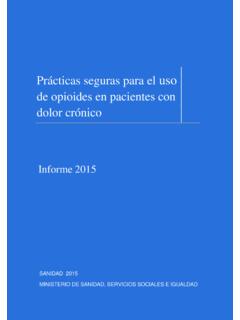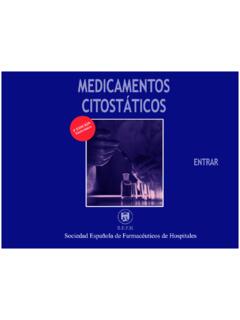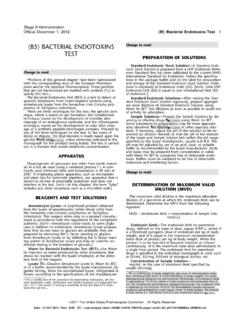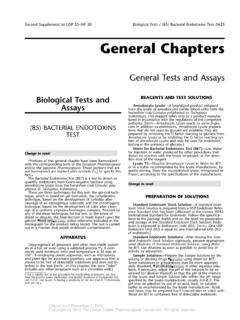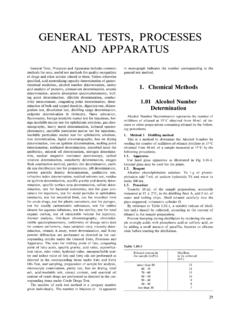Transcription of 797 PHARMACEUTICALthan those described in this …
1 Revision Bulletin 797 Pharmaceutical Compounding Sterile Preparations1 change to read :quality standards for CSPs of drugs and nutrientsbased on current scientific information and beststerile compounding practices. The use of technol-ogies, techniques, materials, and procedures otherthan those described in this chapter is not prohib- 797 PHARMACEUTICAL ited so long as they have been proven to be equiva-lent or superior with statistical significance toCOMPOUNDING those described herein. The standards in this chap-STERILE PREPARATIONSter do not pertain to the clinical administration ofCSPs to patients via application, implantation, in-fusion, inhalation, injection, insertion, instillation,and irrigation, which are the routes of administra-INTRODUCTION tion.
2 Four specific categories of CSPs are de-The objective of this chapter is to describe con-scribed in this chapter: low-risk level, medium-riskditions and practices to prevent harm, includinglevel, and high-risk level, and immediate use. Ster-death, to patients that could result from (1) micro-ile compounding differs from nonsterile com-bial contamination (nonsterility), (2) excessivepounding (see Pharmaceutical Compound-bacterial endotoxins, (3) variability in the intendeding Nonsterile Preparations 795 and Goodstrength of correct ingredients that exceeds eitherCompounding Practices 1075 ) primarily by re-monograph limits for official articles (see offi-quiring the maintenance of sterility when com-cial and article in the General Notices and Re-pounding exclusively with sterile ingredients andquirements) or 10% for nonofficial articles, (4)
3 Un-components ( , with immediate-use CSPs, low-intended chemical and physical contaminants, andrisk level CSPs, and medium-risk level CSPs) and(5) ingredients of inappropriate quality in com-the achievement of sterility when compoundingpounded sterile preparations (CSPs). Contami-with nonsterile ingredients and components ( ,nated CSPs are potentially most hazardous to pa-with high-risk level CSPs). Some differences be-tients when administered into body cavities,tween standards for sterile compounding in thiscentral nervous and vascular systems, eyes, andchapter and those for nonsterile compounding injoints, and when used as baths for live organs andPharmaceutical Compounding Nonsterile Prepa-tissues.
4 When CSPs contain excessive bacterial en-rations 795 include, but are not limited to, ISO-dotoxins (see Bacterial Endotoxins Test 85 ), theyclassified air environments (see Table 1); person-are potentially most hazardous to patients whennel garbing and gloving; personnel training andadministered into the central nervous in principles and practices of aseptic ma-Despite the extensive attention in this chapter tonipulations and sterilization; environmental qualitythe provision, maintenance, and evaluation of airspecifications and monitoring; and disinfection ofquality, the avoidance of direct or physical contactgloves and surfaces of ISO Class 5 (see Table 1)contamination is paramount.
5 It is generally that direct or physical contact of criti-cal sites of CSPs with contaminants, especially mi-crobial sources, poses the greatest probability ofrisk to patients. Therefore, compounding personnelmust be meticulously conscientious in precludingcontact contamination of CSPs both within andoutside ISO Class 5 (see Table 1) achieve the above five conditions and prac-tices, this chapter provides minimum practice andCopyright 2008 The United States Pharmacopeial ConventionAll Rights 797 Pharmaceutical Compounding Sterile Preparations Revision BulletinTable 1. ISO Classification of Particulate Mat-thalmic drops and ointments, and tissueter in Room Air (limits are in particles of m and larger per cubic meter [current ISO] and(2) Manufactured sterile products that are eithercubic feet [former Federal Standard No.)]
6 209E,prepared strictly according to the instructionsFS 209E])*appearing in manufacturers approved label-ing (product package inserts) or prepared dif-Class NameParticle Countferently than published in such [NOTE The FDA states that FS209E,does not include mixing, reconstituting, orClass209 EISO, m3ft3similar acts that are performed in accordance3 Class the directions contained in approved la-4 Class 1035210beling provided by the product s manufac-5 Class 1003,520100turer and other manufacturer directions con-6 Class 1,00035,2001,000sistent with that labeling [(21 USC 321 (k)7 Class 10,000352,00010,000and (m)]. However, the FDA-approved label-8 Class 100,0003,520,000100,000ing (product package insert) rarely describes*Adapted from former Federal Standard No.
7 209E, General Servic-environmental quality ( , ISO Class air des-es Administration, Washington, DC, 20407 (September 11, 1992)ignation, exposure durations to non-ISOand ISO 14644-1 : 1999, Cleanrooms and associated controlled en-vironments Part 1: Classification of air cleanliness. For example,classified air, personnel garbing and gloving,3,520 particles of m per m3 or larger (ISO Class 5) is equiva-and other aseptic precautions by which sterilelent to 100 particles per ft3 (Class 100) (1 m3 = ft3).products are to be prepared for administra-The standards in this chapter are intended to ap-tion). Beyond-use exposure and storage datesply to all persons who prepare CSPs and all placesor times (see General Notices and Require-where CSPs are prepared ( , hospitals and otherments and Pharmaceutical Compound-healthcare institutions, patient treatment clinics,ing Nonsterile Preparations 795 ) for ster-pharmacies, physicians practice facilities, andile products that have been either opened orother locations and facilities in which CSPs areprepared for administration are not specifiedprepared, stored, and transported).
8 Persons whoin all package inserts for all sterile sterile compounding include pharmacists,Furthermore, when such durations are speci-nurses, pharmacy technicians, and , they may refer to chemical stability andThese terms recognize that most sterile compound-not necessarily to microbiological purity oring is performed by or under the supervision ofsafety.]pharmacists in pharmacies and also that this chap-ter applies to all healthcare personnel who prepare,ORGANIZATION OF this CHAPTER store, and transport CSPs. For the purposes of thischapter, CSPs include any of the following:The sections in this chapter are organized to fa-(1) Compounded biologics, diagnostics, drugs,cilitate the practitioner s understanding of the fun-nutrients, and radiopharmaceuticals, includingdamental accuracy and quality practices for pre-but not limited to the following dosage formsparing CSPs.
9 They provide a foundation for thethat must be sterile when they are adminis-development and implementation of essential pro-tered to patients: aqueous bronchial and nasalcedures for the safe preparation of low-risk, med-inhalations, baths and soaks for live organsium-risk, and high-risk level CSPs and immediate-and tissues, injections ( , colloidal disper-use CSPs, which are classified according to the po-sions, emulsions, solutions, suspensions), irri-tential for microbial, chemical, and physical con-gations for wounds and body cavities, oph-tamination. The chapter is divided into the follow-ing main sections:Copyright 2008 The United States Pharmacopeial ConventionAll Rights Bulletin 797 Pharmaceutical Compounding Sterile Preparations3 Definitionsentry, CSP labeling, and other high-particulate-generating activities are performed.
10 It is also a Responsibility of Compounding Personneltransition area that (1) provides assurance that CSP Microbial Contamination Risk Levelspressure relationships are constantly maintained so Personnel Training and Evaluation in Asepticthat air flows from clean to dirty areas and (2) re-Manipulation Skillsduces the need for the heating, ventilating, and air- Immediate-Use CSPsconditioning (HVAC) control system to respond to Single-Dose and Multiple-Dose Containerslarge Hazardous Drugs as CSPs Radiopharmaceuticals as CSPsAseptic Processing (see Microbiological Evalu- Allergen Extracts as CSPsation of Clean Rooms and Other Controlled Envi- Verification of Compounding Accuracy andronments 1116 ) A mode of processing pharma-Sterilityceutical and medical products that involves the Environmental Quality and Controlseparate sterilization of the product and of the Suggested Standard Operating Procedurespackage (containers closures or packaging ma-(SOPs)terial for medical devices)
